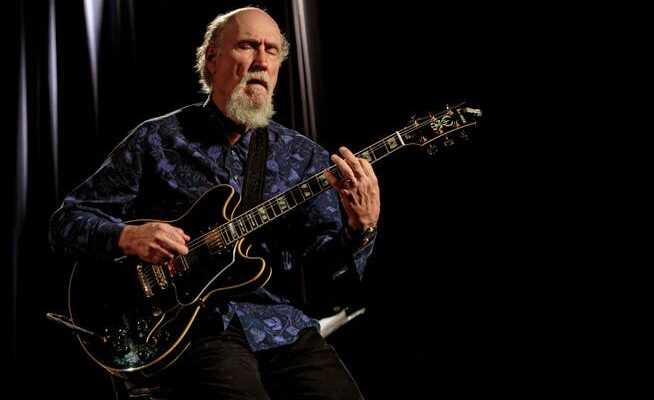With him, everything that is difficult seems easy and handy. Guitarist John Scofield combines jazz with rock, blues and country in his style. At the age of 70 he recorded his first solo album.
John Scofield performing in Milan, November 2021.
He began his career as a sideman for jazz legends such as Chet Baker, Charles Mingus and Lee Konitz. He was instrumental in Miles Davis’ comeback in the 1980s. And since then he has not only been regarded as a pioneering stylist at the intersection of jazz and rock. John Scofield is one of the few stars in jazz.
He never played particularly fast, particularly loud or virtuoso. He always knew how to take a step back in order to give his own sounds and the playing of his fellow musicians enough space. But John Scofield has an unerring instinct for motifs that are as catchy as they are original. And by opening himself up to popular styles like blues, rock, funk, gospel or country, he never neglects the groove.
In dialogue with the loop device
Between a concert in the USA with his quartet Yankee Go Home and his departure for Zurich, where he embarks on a European tour as a trio, Scofield finds time for a video chat. He turned 70 last December, just at the end of an 18-month hiatus from the stage due to the pandemic – the longest since the beginning of his career.
In contrast to many jazz musicians, whose existence was threatened by the pandemic, he could afford the break. “It was great to be home,” he says. And of course the busy musician, who brings new bands to the stage and releases new albums every year, did not remain idle in his New York apartment either.
He did what all musicians did in lockdown, he practiced and played by himself. But he also did what guitarists in particular do when there are no other players around: he played with a loop device that repeats recorded phrases in order to be able to play along with himself, so to speak.
The looped accompaniment patterns were not only used for practice purposes. Rather, he worked towards a live performance in which he can spontaneously influence and vary the accompaniment loops using the loop device. Once he had enough material, he went into the studio with his guitar and effects to record a series of tracks.
The compositions of the resulting solo album, which is now being released by the Munich label ECM, provide an overview of the variety of genres that inspired and shaped Scofield in the course of his life. Even more. They combine to form a kind of musical self-portrait. In addition to jazz standards like “There Will Never Be Another You” and an original by Keith Jarrett, the repertoire includes folk songs like “Danny Boy”, a rock-n-roll piece by Buddy Holly and a country song by Hank Williams. For this purpose, John Scofield has selected a handful of his own compositions from various phases of his work.
When asked about his main musical influences, Scofield declines. “What the hell!” Of course he was inspired by everything he had heard and absorbed in his long life. Even today he keeps coming back to the jazz classics, but also to the heroes of his childhood, the blues and rock guitarists of the sixties.
More recently, Scofield has increasingly turned to popular styles, but in order to transform the evergreens into his own pithy melody and brittle, sometimes singing, sometimes rasping sound. On the album “Country for Old Men” (2016) country melts into sophisticated jazz, on “Hudson” (2017) the same happens with pieces by Bob Dylan, Joni Mitchell and Jimi Hendrix. Conversely, in a series of concerts with the band Gov’t Mule, he introduced jazzy elements into a rock formation in his solos.
After about 45 albums under his own name and many more as a sideman, Scofield can now be heard all alone for over an hour for the first time. The classic solo playing in the tradition of guitarists like Joe Pass or Ted Greene, which does not require any technical aids and weaves melody, harmony and bass tones into a complex arrangement, is not his thing. By looping and focusing on his single-note lines, Scofield stays on his ledges, so to speak.
The virtue of reduction
With his guitar sound on the edge between clean and distorted, he has the opportunity to demonstrate his nuanced technique, which is characterized by so-called bends, glissandi and a dynamic attack. Scofield’s improvisation, however, in its inimitable marriage of a rough, angular side with a warm and songful moment, comes into its own when he plays without an accompaniment sequence and his stupendous sense of timing and groove speaks from his solo lines alone.
Whether playing bebop or country, John Scofield is instantly recognizable. How did he develop his incisive style of play? “My technical limits have given me the style,” he says laconically and modestly. But that is at most part of the truth. In fact, John Scofield never set out to boast of virtuosity. To this end, he practiced the virtue of reduction and continually refined the quality of his tone and phrases.
By playing solo with a loop device, Scofield’s repertoire of formations is now richer by one variant. But he doesn’t limit himself to that. After the European tour as a trio, he will give further concerts in the USA with the jazz-rock ensemble Yankee Go Home and will go into the studio for a new album. Only then does he start a solo tour.
Concert: Zurich, Moods, May 12.
